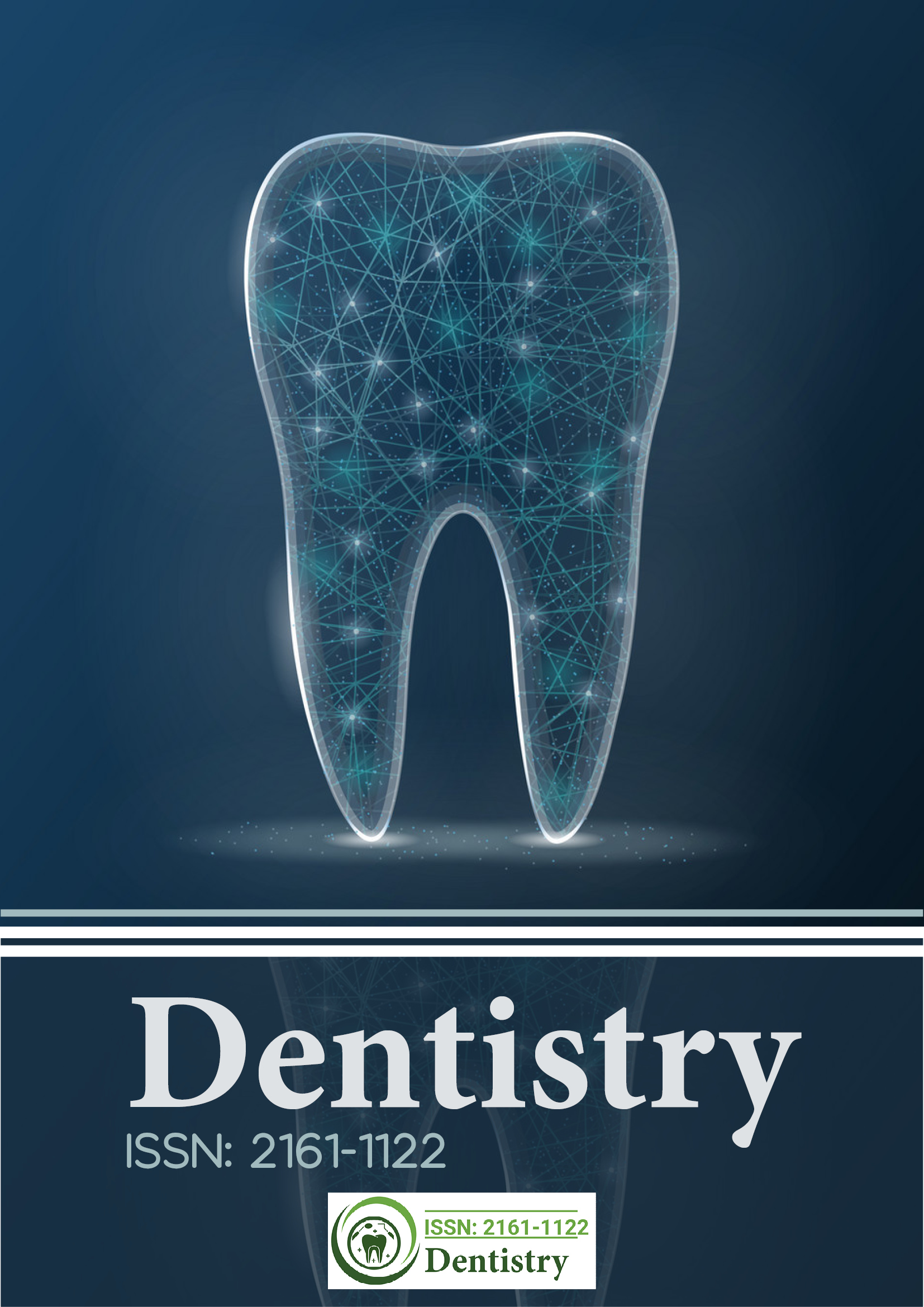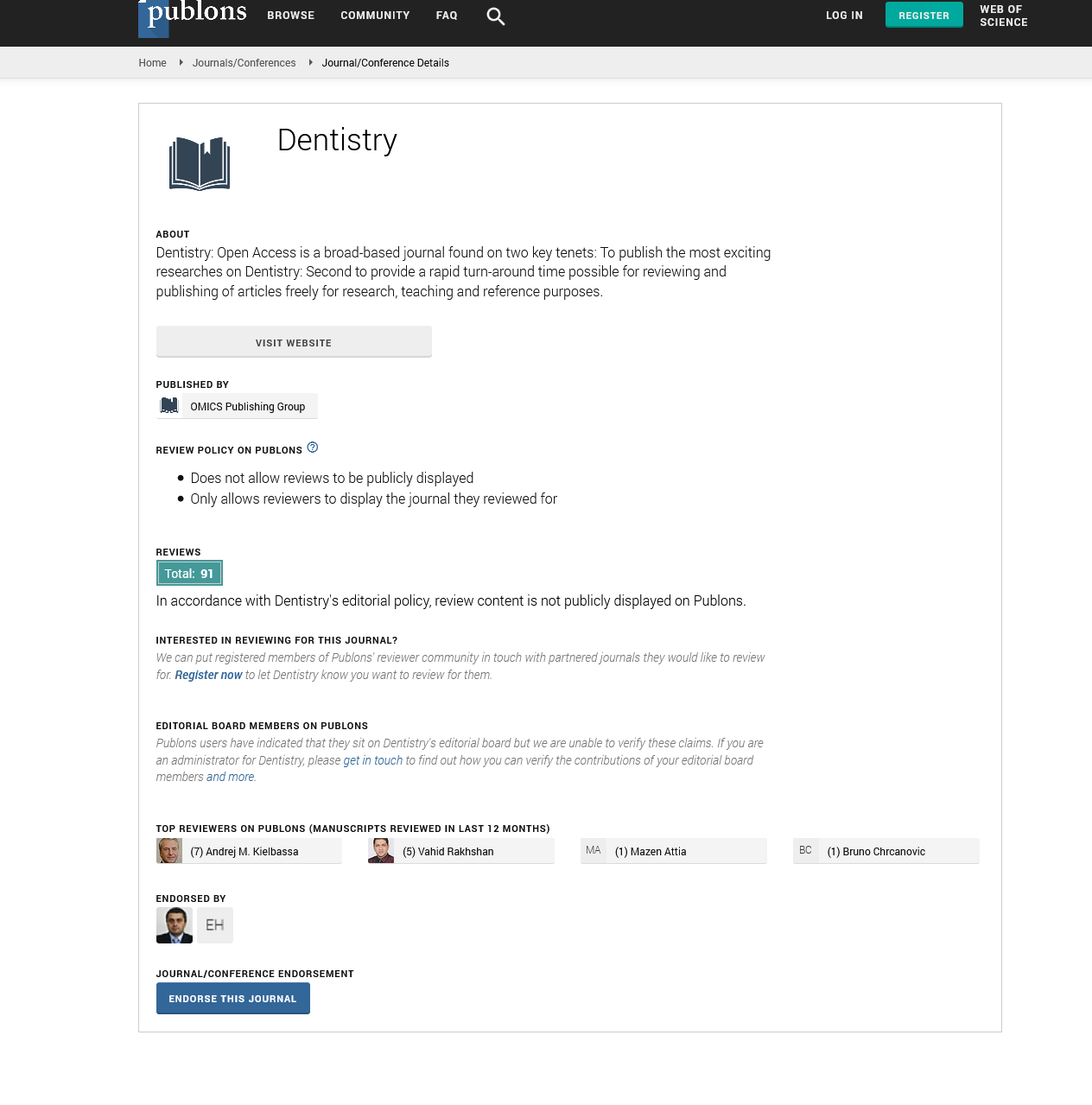Citations : 2345
Dentistry received 2345 citations as per Google Scholar report
Indexed In
- Genamics JournalSeek
- JournalTOCs
- CiteFactor
- Ulrich's Periodicals Directory
- RefSeek
- Hamdard University
- EBSCO A-Z
- Directory of Abstract Indexing for Journals
- OCLC- WorldCat
- Publons
- Geneva Foundation for Medical Education and Research
- Euro Pub
- Google Scholar
Useful Links
Share This Page
Journal Flyer

Open Access Journals
- Agri and Aquaculture
- Biochemistry
- Bioinformatics & Systems Biology
- Business & Management
- Chemistry
- Clinical Sciences
- Engineering
- Food & Nutrition
- General Science
- Genetics & Molecular Biology
- Immunology & Microbiology
- Medical Sciences
- Neuroscience & Psychology
- Nursing & Health Care
- Pharmaceutical Sciences
Effectiveness of orthodontic mini-screw implants in adult deep bite patients during incisors intrusion: A systematic review and meta-analysis
24th Global Dentists and Pediatric Dentistry Annual Meeting
June 11-12, 2018 | London, UK
Ahmed I Atalla, Mai H AboulFotouh, Fady H Fahim and Manal Y Foda
Cairo University, Egypt
Posters & Accepted Abstracts: Dentistry
Abstract:
Introduction & Aim: The aim of this systematic review was to compare the effectiveness of temporary anchorage devices (TADs) and conventional intrusive arches (CIA) during incisor intrusion in adult patients with a deep bite and their adverse effects. Methods: Four electronic databases were queried. In addition, articles were manually searched for using the reference lists of relevant articles, grey literature, and peer-reviewed orthodontic journals. Non-English articles were excluded from the review. Data from the retrieved articles were selected and evaluated by two independent reviewers using a new systematic review software program, DistillerSR. A meta-analysis of raw mean differences was performed. Results: Initially, we retrieved 9600 articles, but the selection process resulted in 6 articles. The included studies ranged from low to high in quality. Meta-analysis showed that TADs enabled 0.78 mm more upper incisor intrusion than the conventional method (95% CI=0.28 to 1.29). There was no significant anchorage loss difference in the CIA group compared to the TAD group (MD -3.68; 95% CI -7.41 to 0.05). Also, a significant molar tipping of 1.03 degrees was observed in the CIA group (P=0.008) compared to the TAD group (MD -1.03; 95% CI -1.79 to -0.27). Conclusion: The results of this meta-analysis showed that patients receiving TADs had 0.78 mm greater upper incisor intrusion than patients receiving the conventional treatment. This was statistically significant but not clinically relevant. No clinical difference was found between TADs and the conventional method of anchorage loss. Recent Publications 1. Sensk NE and Turkkahraman H (2012) Treatment effects of intrusion arches and mini-implant systems in deep bite patients. American Journal of Orthodontics and Dentofacial Orthopaedics. 141(6):723â?? 33. 2. Polat-Ozsoy O, Arman-Ozcirpici A, Veziroglu F and Cetinsahin A (2011) Comparison of the intrusive effects of miniscrews and utility arches. American Journal of Orthodontics and Dentofacial Orthopaedics. 139(4):526â??32. 3. Ng J, Major PW, Heo G and Flores-Mir C (2005). True incisor intrusion attained during orthodontic treatment: a systematic review and meta-analysis. American journal of orthodontics and dentofacial orthopaedics : official publication of the American Association of Orthodontists, its constituent societies, and the American Board of Orthodontics. 128(2):212â??9. 4. Raj A, Acharya SS, Mohanty P, Prabhakar R, MK K, Saravanan R, et al(2015). Comparison of Intrusive Effects of Mini screws and Burstone Intrusive Arch: A Radiographic Study. Adv Hum Biol. 5(2):49â??55. 5. Nayak US Krishna, Goyal Varun, Godhrawala Farhat and Saxena Rahul (2011). Comparison of Skeletodental Changes Occurring during Deep Overbite Correction with Mini-Implant Anchorage System and the Utility Arches Reinforced by a Transpalatal Arch. Original Article. 45:9â??14.
Biography :
Ahmed I Atalla has completed his Bachelor degree (Dentistry) from Mansoura University, Egypt. He completed his MSc (Orthodontics) from Cairo University, Egypt.
Email:ahmed.atalla@dentistry.cu.edu.eg

